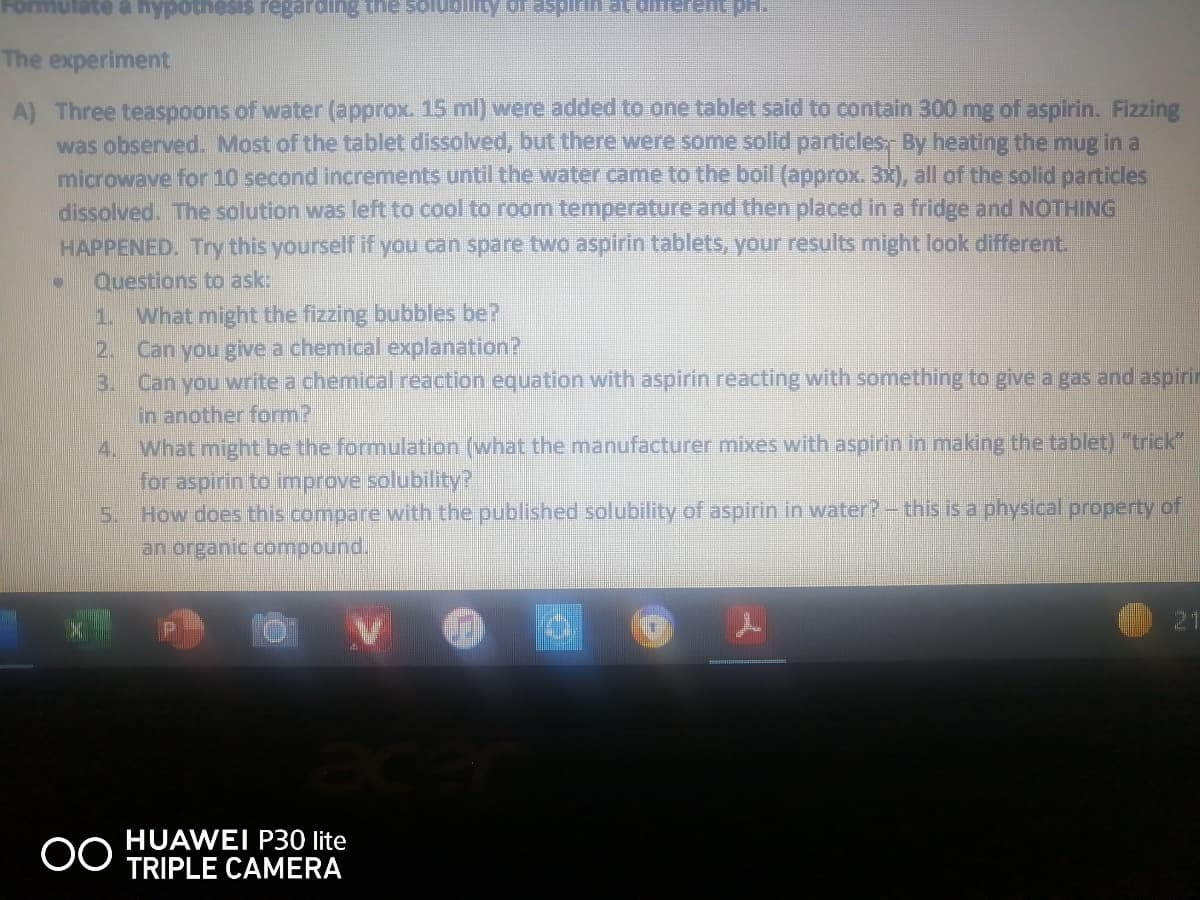A) Three teaspoons of water (approx. 15 ml) were added to one tablet said to contain 300 mg of aspirin. Fizzing was observed. Most of the tablet dissolved, but there were some solid particles, By heating the mug in a microwave for 10 second increments until the water came to the boil (approx. 3x), all of the solid particles dissolved. The solution was left to cool to room temperature and then placed in a fridge and NOTHING HAPPENED. Try this yourself if you can spare two aspirin tablets, your results might look different. Questions to ask: 1. What might the fizzing bubbles be? 2. Can you give a chemical explanation? 3. Can you write a chemical reaction equation with aspirin reacting with something to give a gas and aspiri in another form? 4. What might be the formulation (what the manufacturer mixes with aspirin in making the tablet) trick for aspirin to improve solubility? 5. How does this compare with the published solubility of aspirin in water?- this is a physical property of an organic compound.
A) Three teaspoons of water (approx. 15 ml) were added to one tablet said to contain 300 mg of aspirin. Fizzing was observed. Most of the tablet dissolved, but there were some solid particles, By heating the mug in a microwave for 10 second increments until the water came to the boil (approx. 3x), all of the solid particles dissolved. The solution was left to cool to room temperature and then placed in a fridge and NOTHING HAPPENED. Try this yourself if you can spare two aspirin tablets, your results might look different. Questions to ask: 1. What might the fizzing bubbles be? 2. Can you give a chemical explanation? 3. Can you write a chemical reaction equation with aspirin reacting with something to give a gas and aspiri in another form? 4. What might be the formulation (what the manufacturer mixes with aspirin in making the tablet) trick for aspirin to improve solubility? 5. How does this compare with the published solubility of aspirin in water?- this is a physical property of an organic compound.
Chapter31: Introduction To Analytical Separations
Section: Chapter Questions
Problem 31.19QAP
Related questions
Question
100%
Please help with number 4

Transcribed Image Text:PudauejaeAR UUidse jo Aumanios aun Buipjeda sseuodAy e e3en
The experiment
A) Three teaspoons of water (approx. 15 ml) were added to one tablet said to contain 300 mg of aspirin. Fizzing
was observed. Most of the tablet dissolved, but there were some solid particles, By heating the mug in a
microwave for 10 second increments until the water came to the boil (approx. 3x), all of the solid particles
dissolved. The solution was left to cool to room temperature and then placed in a fridge and NOTHING
HAPPENED. Try this yourself if you can spare two aspirin tablets, your results might look different.
Questions to asks
1. What might the fizzing bubbles be?
2. Can you give a chemical explanation?
3/Can you write a chemical reaction equation with aspirin reacting with something to give a gas and aspirin
in another form?
What might be the formulation (what the manufacturer mixes with aspirin in making the tablet) "trick
for aspirin to improve solubility?
How does this compare with the published solubility of aspirin in water?- this is a physical property of
an organic compound.
4.
5.
HUAWEI P30 lite
TRIPLE CAMERA
Expert Solution
This question has been solved!
Explore an expertly crafted, step-by-step solution for a thorough understanding of key concepts.
Step by step
Solved in 2 steps

Knowledge Booster
Learn more about
Need a deep-dive on the concept behind this application? Look no further. Learn more about this topic, chemistry and related others by exploring similar questions and additional content below.Recommended textbooks for you



Chemistry
Chemistry
ISBN:
9781305957404
Author:
Steven S. Zumdahl, Susan A. Zumdahl, Donald J. DeCoste
Publisher:
Cengage Learning



Chemistry
Chemistry
ISBN:
9781305957404
Author:
Steven S. Zumdahl, Susan A. Zumdahl, Donald J. DeCoste
Publisher:
Cengage Learning

Chemistry: An Atoms First Approach
Chemistry
ISBN:
9781305079243
Author:
Steven S. Zumdahl, Susan A. Zumdahl
Publisher:
Cengage Learning


Principles of Instrumental Analysis
Chemistry
ISBN:
9781305577213
Author:
Douglas A. Skoog, F. James Holler, Stanley R. Crouch
Publisher:
Cengage Learning